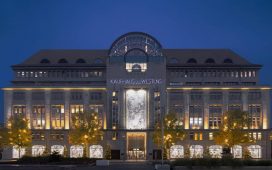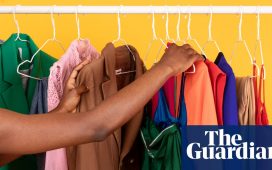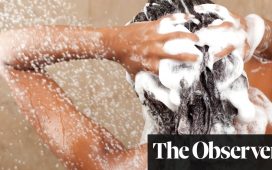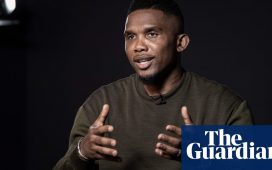Spanish
sustainable fashion label Ecoalf is trying to clean up the fashion industry
by tackling some of its biggest issues – namely its excessive consumption
of the world’s natural resources and its astronomical production of waste.
Founded in 2009 by Javier Goyeneche, the brand looks to close the loop on
raw material production by using breakthrough technologies to produce
garments entirely from recycled materials.
In 2015, the fashion brand, which is the first in Spain to be awarded
B-Corp certification, launched Upcycling the Oceans, an initiative that
works with the fishing sector to clean the ocean of waste materials which
are then turned into new fabrics. The brand has so far launched two
Upcycling the Ocean projects – one in Spain and one in Thailand – and has
collaborated with more than 550 boats and more than 3,000 voluntary
fishermen to recover marine litter – including plastic bottles, nylon,
cotton, wool and even used tires – which it then turns into fashion
garments. Since 2015, the company has recovered 500 tonnes of marine
waste.
Today, the fast-growing brand has flagship stores in Madrid, Berlin,
Barcelona, Amsterdam and Malaga – with a store in Tokyo set to mark its
launch into the Japan market when it opens in March. Ahead of the store
opening, FashionUnited spoke with Ecoalf CEO Marisa Selfa about the brand’s
presence at the recently ended trade fair season, the challenges of
creating a truly sustainable brand, the industry’s growing issue of
greenwashing and Ecoalf’s global ambitions.
Which trade fairs do you normally attend?
We attend Neonyt, Premium and Pitti Uomo – those are the important ones
for us. We did Who’s Next in Paris about three seasons ago but we found
that it wasn’t very successful for us. We didn’t get a very good space
there and our women’s collection wasn’t as advanced as it is now. We
decided then that these three were the best for us, but it doesn’t mean we
won’t go back. Paris is a really important market for us and it feels like
there are a lot of exciting changes going on at Who’s Next at the
moment.
What are your biggest markets at the moment and which ones are you most
excited about?
Spain is our biggest market still but our international market is
growing quickly – we have over 1,500 points of sales in Europe and stores
in Spain, Germany and Holland. Japan is also a really exciting market for
us – we’ve launched a joint venture with the Sanyo Group and we are going
to be opening our first store there in Tokyo in March.
Why did you decide on Japan?
I think in Japan they are really excited about sustainability – they are
really hungry for it. For us, it was a market where we wouldn’t necessarily
have gone to ourselves this early on if we hadn’t found Sanyo – that’s to
say, we still have a lot to do in Europe. But finding a partner like that,
one that is a real key player in the industry, was the perfect opportunity
to enter the market with the expertise of the local professionals.
The move isn’t just about going there with our products and opening
stores, it’s also a great opportunity for us to replicate and expand our
Upcycling in the Oceans project which is helping to clean the world’s
oceans. We began the project in 2015 in Spain with the help of HAP
Foundation and have been expanding it since then. For example, we currently
have 3,000 fishermen in Thailand collecting around one tonne of waste each
day from the ocean and we are going to be working with Sanyo to replicate
that project in Japan.
How is the UK market doing?
We have a new agent in the UK for this season and we’re excited about
it. At the moment we are not very big there but I don’t think we’ve had the
right partnerships in the past and we are hoping that will change now.
Eventually, we would like to have our own stores there.
What are your plans for expansion?
There is always room for improvement and right now we are really growing
comfortably. We are omnichannel: we have our own stores, shop-in-shops in
department stores, wholesale accounts and online. Our e-commerce is really
booming at the moment – it’s doing really well in Europe and now as I said
we are opening in Asia.
We’re planning on going to the US and so going to trade shows like
Pitti, where most of the big buyers of all the key accounts go, is a great
opportunity for us to prepare for it. We don’t want to enter any markets
until we are completely ready or find the right partners to move forward
with. At the moment we are looking into the best way to enter into the US
because it is a very big and important market and you really can’t make a
mistake there.
What do you mean by that?
If you enter into that market with the wrong partner and you end up
going to the wrong distribution then it’s really hard to get to the level
that we want to get to. The US is also very price-driven and we as a brand
are not promotion driven – we have basic products that we want the customer
to buy and wear for a long time. We don’t get into seasonal meets seasons,
we just do the sales in January and again in July. So we have to make sure
we find a partner who respects that ethos and philosophy. On top of that,
there’s the task of working out whether we enter through wholesale or do we
do retail straight away? All these things you have to consider and so at
the moment we are researching that and talking to some possible partners
about it and hope to be there soon.
What do you think about the new concentration on sustainability at
trade fairs such as the introduction of new sustainability sections and the
launching of new initiatives?
I think it’s very important and I’m really glad trade fairs are stepping
up their game and making sustainability a real priority. Sustainability
really isn’t a trend, it’s something that is transforming businesses and it
is here to stay. At the same time, as trade shows focus more on
sustainability they really have to be careful about how they do it. If they
have a sustainable section, they need to make sure the brands there are
truly sustainable and that they’re not just putting brands there to fill up
the space. But in general, I think any progress is a positive thing. When
it comes to an issue like sustainability, even if it’s a little bit it’s
better than nothing.
How does a brand manage to be truly sustainable?
If brands want to be truly sustainable – and there are very few doing
that in my opinion – you have to think about the whole supply chain, not
simply concentrate on one small aspect and forget the rest. For Ecoalf,
sustainability is not just about the fabrics that are recycled or just
about the sourcing or just about codes of conduct – it’s about the bigger
picture and considering all of these aspects.
True sustainability is also about educating and I think brands have a
duty not just to sell sustainable fashion but to explain to the consumer
why they are selling it. The more voices we have talking about
sustainability issues the better. Last year, for example, we did 300
conferences where we spoke about what is happening in terms of
sustainability in the fashion industry. I think the effect the fashion
industry is having on the environment is immense and it calls for a very
immediate change – brands, suppliers and the consumer all need to change –
it requires a collaborative effort.

percent recycled PET with Gold primaloft upper filling, thermo-sealed
seams, magnetic closures and recycled zipper.
What do you think about the issue of greenwashing in the industry?
There are a lot of big brands doing sustainable or recycled capsules at
the moment, but then their overall business models just aren’t sustainable.
I think the words ‘eco’ and ‘sustainability’ have really been thrown around
so much they’ve almost lost their meaning. Sustainable isn’t just about
recycled fabric, it is about how you produce it, where did you get the raw
material, how are you moving it, are you shipping it by air? A lot of
different factors need to be considered.
Many companies seem to think this is a trend just to grab the customer
and get them to buy their products. It seems they are very big on the
communication of sustainability but very light on the execution of it –
that annoys me. It can also be very misleading – while some consumers are
super savvy there are others that aren’t, and they can end up buying things
that perhaps aren’t as sustainable as they thought.
“My wish is that Ecoalf becomes a truly global brand”
I think the industry has to pay more attention to greenwashing because a
lot of people will say this is sustainable when it really is not and
consumers are starting to ask questions and see through that. People are
really starting to ask, ‘what exactly do you mean by this statement?’ The
client is starting to push for more honesty and transparency which I think
will push the brands.
We see that hunger to find out more about what true sustainability is in
our customers, too, which is great. The people that come to our stores, our
final customers, those are the ones that really become the ambassadors for
the brand. They come in, they love the story, they see how our clothes are
made and what’s on the labels, then they come back with somebody else
telling the story about it. I think that’s really important too – the more
final customers that really believe in this, then the more the industry
will have to listen. It’s the customer who really is asking for change and
pushing for it. We all have to change because that’s what they want.
What are the biggest challenges you face as a sustainable brand?
The biggest challenge is being sustainable across the whole business
model, not just with the products. For a fashion business to be truly
sustainable it means the way you grow has to be very tactical. You can’t
just be opening and closing stores everywhere and pushing for more and more
sales or going for higher margins because that can mean cutting corners in
production or with suppliers. We have to be truly demanding and strict with
suppliers to make sure they follow our regulations.
Of course, it can be hard and sometimes you have to make tough
decisions, sometimes you’ll have to say no to certain things, sometimes
suppliers aren’t even ready for this. For example, one component which is
still difficult to make sustainably is the zipper. It is very hard to find
good quality and fully recycled zippers so we are working with suppliers
because that doesn’t exist yet. Another example can be seen in footwear:
just this season we found a new supplier that does recycled laces, before
that we couldn’t find any. That’s another example of suppliers changing –
the industry is making the suppliers change.

nylon, with a personalized outsole.
Also, using organic cotton is our last option – we don’t like it,
because it still uses a lot of water. We only used recycled cotton. There
are also some prints we just can’t do because we don’t use plastics. We
also don’t make polar fleeces, even though we know we could sell a lot of
them, because they’re not very good for the planet. If anything in our
collection is not 100 percent recycled it’s because we can achieve that
quality or it simply doesn’t exist.
The whole system is so complicated because if you compare us with your
average brand, it is more complicated to do it the way we are doing it when
for example you abide by rules such as you can’t fly certain materials from
one region to another because it is not sustainable – even if the material
itself is sustainable. Or you might have lower margins because some fabrics
take a long time to go from, say, a plastic bottle to a fabric – that takes
a process that a normal polyester you’d buy isn’t going to take. Some of
our fabrics take 120 days to be produced – others can take just 30 days.
That’s why it’s really challenging to be truly sustainable – You have to
weigh a lot of things up. If you want faster revenue and higher margins
then it’s easier to do it the not sustainable way.
What is Ecoalf’s plan for the next 5 to 10 years?
My wish is that Ecoalf becomes a truly global brand; not just a Spanish
or European brand but a truly global one. I’m hoping we are able to
influence the industry in a big way and set the bar for other sustainable
brands to follow.
We also want to – and look forward to – helping other industries. We
have done some co-branding and corporate business in the past and are
excited to do more. For example, we’ve done uniforms for hotels because
they wanted to be more sustainable. With other big companies we do VIP
presence or merchandise for conferences and big events – that’s an
important and useful way to influence other industries, not just the
fashion industry.
Photos courtesy of the brand














